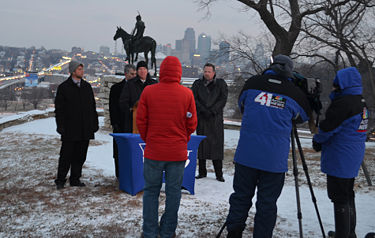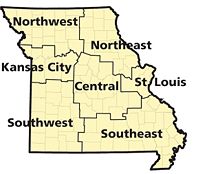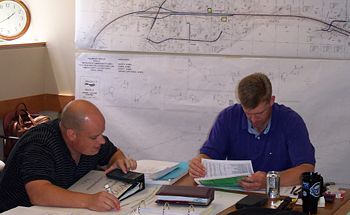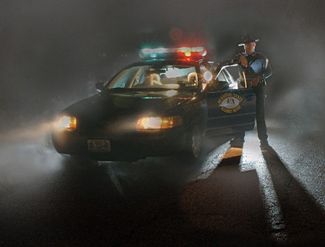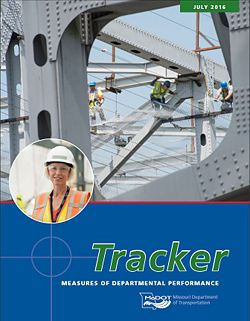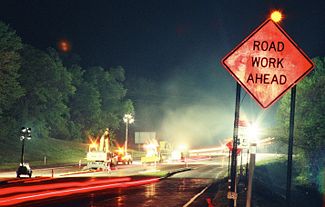616.14 Work Zone Safety and Mobility Policy
MoDOT is committed to providing safe and efficient movement of both motorized and non-motorized traffic through or around temporary traffic control zones and protecting workers and equipment located within those areas. As such, MoDOT focuses on the visibility of temporary traffic control devices and traffic flow through work zones located on the state highway system. Our staff’s and partners’ attention to improved work zone visibility and mobility, from the preliminary planning stages through the end of all work, results in safer work zones with minimal impact on the traveler - a benefit to all.
Contents
- 1 616.14.1 Goals
- 2 616.14.2 Fundamental Principles
- 3 616.14.3 Organization and Responsibilities
- 3.1 616.14.3.1 Central Office
- 3.2 616.14.3.2 District Offices
- 3.2.1 616.14.3.2.1 District Engineers
- 3.2.2 616.14.3.2.2 Community Relations' Managers and/or Customer Service Representatives
- 3.2.3 616.14.3.2.3 District Work Zone Coordinator
- 3.2.4 616.14.3.2.4 Project Core Team
- 3.2.5 616.14.3.2.5 Field Operation Forces
- 3.2.6 616.14.3.2.6 Resident Engineers
- 3.2.7 616.14.3.2.7 District Permit Staff
- 3.3 616.14.3.3 Work Zone Quality Circle
- 3.4 616.14.3.4 Work Zone Review Team
- 3.5 616.14.3.5 Federal Highway Administration
- 3.6 616.14.3.6 Contractor
- 3.7 616.14.3.7 Permittee
- 3.8 616.14.3.8 Temporary Traffic Control Product Manufacturers, Vendors, Suppliers and Trade Associations
- 3.9 616.14.3.9 Law Enforcement
- 3.10 616.14.3.10 Municipalities, Townships, Counties and Other Non-MoDOT Agencies or Corporations With Projects Utilizing Federal Funds
- 4 616.14.4 Policy-Related Guidelines
- 5 616.14.5 Tracking Measures
- 6 616.14.6 Training
- 7 616.14.7 Process Review
- 8 616.14.8 Significant Projects
- 9 616.14.9 Assessment of Work Zone Impacts
- 10 616.14.10 Work Zone Transportation Management Plan
- 11 616.14.11 General Public Information
- 12 616.14.12 Travel Time Information
- 13 616.14.13 Roadway Capacity Considerations
616.14.1 Goals
Compliance with the guidelines outlined in this document enables MoDOT and its partners to meet the following work zone goals:
- Provide an environment conducive to roadway user and worker safety.
- Work toward zero work zone fatalities.
- Reduce crashes in all types of work zones.
- Minimize impact of work zones on roadway user.
- Limit traffic delays to 15 minutes or less.
- Provide customers real-time work zone information.
616.14.2 Fundamental Principles
The safe and efficient movement of roadway users and worker safety are integral and high-priority elements of every incident management, construction, maintenance, permit and utility operation. Consideration of the following principles enhances the performance of the temporary traffic control zone:
- Preparing a temporary traffic control plan and communicating it to all responsible parties prior to occupying the site.
- Providing those whose actions affect the temporary traffic control zone with training appropriate to their level of responsibility.
| Work Zone Safety and Mobility Policy Resources |
| Links to EPG, spec, standard plan, MUTCD and FHWA resources |
- Employing the same basic safety principles used to design permanent roadways.
- Avoiding frequent or abrupt geometric changes.
- Minimizing delay and disruption.
- Scheduling and coordinating operations.
- Providing adequate warning, delineation, and channelization in advance of and through the area affected.
- Providing positive guidance.
- Providing for safe operation of work.
- Encouraging use of alternative routes.
- Assuming drivers will only reduce their speeds if they clearly perceive a need to do so.
- Providing for reasonably safe passage of bicyclists and pedestrians.
- Providing recovery areas where practical.
- Coordinating operations with those having jurisdiction over any affected cross streets, railroads, or transit facilities.
- Ensuring continuation of emergency services.
- Communicating with and providing reasonable accommodations for adjoining property owners.
- Providing and maintaining temporary traffic control devices in good working order, reasonably consistent with the temporary traffic control plan, and effective.
- Monitoring performance of the transportation management plan and modifying as needed.
- Inspecting and maintaining temporary traffic control devices.
- Removing, covering, or turning; and turning off all unnecessary temporary traffic control devices.
- Maintaining a record of any crashes or incidents.
- Storing unused equipment and material in such a manner to reduce the probability of being hit.
- Involving the media to assist in information dissemination.
- Keeping the public, local businesses, trucking and transit associations, government entities, etc. informed of work zone activities.
- Employing incident management strategies.
- Pursuing innovative technologies for advancement of safety and mobility in work zones.
616.14.3 Organization and Responsibilities
616.14.3.1 Central Office
Central Office, under the leadership of Highway Safety/Traffic, is responsible for setting work zone policies and guidelines, identifying and communicating issues related to the condition, design and usage of temporary traffic control devices, as well as the set-up, maintenance, general appearance and functionality of work zones. Responsibilities of Central Office includes:
- Providing work zone direction and guidance.
- Sharing best practices.
- Evaluating the effectiveness of work zones quarterly by tracking the percent of work zones meeting traffic flow and visibility expectations and reporting the results in the Tracker. Refer to EPG 616.14.5 Tracking Measures for more information.
- Performing quality assurance inspections and reviews of work zones on a routine basis and district work zone reviews on an annual basis. Video recording during work zone reviews shall follow EPG 616.14.3.4 Work Zone Review Team guidance for video recording.
- Evaluating work zone safety by tracking the number of fatalities and injuries in work zones annually.
- Continually pursuing improvement of work zone safety and mobility processes and procedures by analyzing the data collected through the above tracking mechanisms.
- Maintaining a database capturing work zone activities occurring on highways across the state and conveying pertinent information to the public via an interactive external website.
- Managing a database of work zone inspection results and providing access to this information via TMS.
- Educating all MoDOT personnel (designers, quality assurance personnel, construction inspectors, flaggers, workers, supervisors, etc.) on work zone guidelines to an appropriate level for the job decisions each individual is required to make. This includes providing training courses and periodic updates reflecting changing industry practices and MoDOT processes and procedures.
616.14.3.2 District Offices
Each district develops and implements their own Quality Control/Quality Assurance plan to meet the requirements set forth in this document, and in accordance with applicable contract documents and guidelines provided in the Manual on Uniform Traffic Control Devices (MUTCD), the Engineering Policy Guide, the MoDOT Work-Zone Guidelines pamphlet, Traffic Control for Field Operations, Quality Standards for Temporary Traffic Control Devices and any other pertinent documents.
616.14.3.2.1 District Engineers
Responsibilities of District Engineers include:
- Designating a district work zone coordinator.
- Supporting the district work zone coordinator in performing assigned duties.
- Ensuring the appropriate district staff is trained in temporary traffic control to a level commensurate with their responsibilities and implement work zone policies and guidelines as set forth in this document.
616.14.3.2.2 Community Relations' Managers and/or Customer Service Representatives
Community relations’ managers and staff, working closely with all the above, are responsible for:
- Gathering and communicating to key stakeholders and the general public the work zone information.
- Updating regularly information needs (prior to, during, and after project is completed).
- Developing communication plans with appropriate staff.
- Disseminating information to both internal and external audiences via various methods as agreed on in the communication plan.
- Providing to all involved with customer feedback relating to the work zone.
616.14.3.2.3 District Work Zone Coordinator
The district work zone coordinator is a resource to be utilized by district staff to assist in designing and maintaining safe and efficient work zones. Responsibilities of district work zone coordinators include:
- Promoting lane closures during off-peak and/or nighttime hours when capacity is an issue.
- Working with appropriate personnel to coordinate lane closures across district boundaries.
- Working with appropriate personnel to schedule work on multiple projects on the same route.
- Working with Project Development to reduce working days for projects requiring lane closures.
- Developing communication strategy/plan with district community relations’ staff for each work zone.
- Entering lane closures into the statewide work zone database.
- Providing district staff with input on work zone design and operation.
- Performing quality assurance of work zones to promote consistency and compliance with policies and guidelines.
- Monitoring work zone inspections and reviews and identifying areas of need for improvement. If the district requests to video record their work zone reviews, the District Work Zone Coordinator shall supervise the review processes and shall follow EPG 616.14.3.4 Work Zone Review Team guidance for video recordings.
- Conducting post construction reviews on major impact work zone projects to determine what successes they had and what improvements need to be implemented on future projects of similar impact.
616.14.3.2.4 Project Core Team
Project core teams will review all projects before they are awarded to reduce work zone impacts on the public. Responsibilities of the project core team includes:
- Review Work Zone Questions for the Core Team with the entire core team from the scoping stage through final plans.
- Conducting traffic analyses to identify work zone impacts to traffic flow and safety.
- Identifying strategies to minimize impact and maximize awareness.
- Developing a traffic control, traffic management, and public information plan, as needed.
- Scheduling lane closures during off-peak and/or at nighttime hours when capacity is an issue.
- Using innovative contracting and bidding options, when possible, to reduce project completion time.
- Evaluating and implementing schedules to reduce the number of working days needed to complete projects quicker.
- Using road closures and/or signed detours, when possible, to complete projects quicker.
- Considering the traffic effects of major sporting events and other special activities when planning work zones.
- Opening additional through lanes to reduce traffic effects when possible.
- Determining work zone speed limits are appropriate in active and non-active work zones.
- Incorporating provisions for real time travel information to the public through the use of changeable message signs (CMS), dynamic message signs (DMS), highway advisory radio, ITS, etc.
- Include appropriate Advanced Work Zone traffic strategies as indicated by the enhanced Work Zone Impact Analysis spreadsheet (refer to EPG 616.13 Work Zone Capacity, Queue and Travel Delay).
616.14.3.2.5 Field Operation Forces
Responsibilities of field operation forces include:
- Requesting lane closures and height, width and weight restrictions approval from the appropriate district staff, as required, two working days prior to lane closures and 14 calendar days prior to roadway restrictions before beginning any non-emergency work.
- Scheduling lane closures during off-peak and/or nighttime hours when capacity is an issue.
- Considering the traffic effects of major sporting events and other special activities when planning work zones.
- Maintaining work zones in a neat, orderly and effective manner for the safety of highway workers and motorists.
- Scheduling multiple tasks in a single work zone, rather than scheduling multiple lane closures in the same area.
- Minimizing delay and disruption experienced during field operations.
- Performing quality control of work zones to determine compliance with policies and guidelines.
- Determining work zone speed limits are appropriate in active and non-active work zones.
- Informing the traveling public of travel times, as needed, through changeable message signs (CMS) or dynamic message signs (DMS).
- Monitoring and adjusting traffic control measures, as needed, to improve traffic flow, visibility and workers and motorist safety.
616.14.3.2.6 Resident Engineers
Resident engineers and staff will assess and manage projects during construction to ensure appropriate action is taken to reduce work zone impacts of those projects on the public. Responsibilities of resident engineers include:
- Designating a trained person at the project level who has the primary responsibility, with sufficient authority, for implementing the EPG 616.14.10 Work Zone Transportation Management Plan (TMP) and other safety and mobility aspects of the project.
- Verifying all contractor personnel are trained in traffic control to a level commensurate with their responsibilities.
- Advising the appropriate district staff, as required, two working days before any work requiring a lane closure begins and 14 calendar days prior to the imposition of height, width and weight restrictions.
- Working with contractors to minimize lane closures.
- Determining work zones are neat, orderly and effective for the safety of highway workers and motorists.
- Minimizing delay and disruption experienced during construction.
- Performing quality control and assurance of work zones to promote consistency and compliance with contract documents, policies and guidelines.
- Determining work zone speed limits are appropriate in active and non-active work zones.
- Identifying the need for and disseminating work zone information to appropriate staff and external sources to increase public awareness.
- Informing the traveling public of travel times, as needed, through changeable message signs (CMS) or dynamic message signs (DMS).
- Monitoring and adjusting traffic control measures, as needed, to improve traffic flow, visibility and workers and motorist safety.
616.14.3.2.7 District Permit Staff
Responsibilities of district permit staff include:
- Coordinating lane closure needs and height, width and weight restrictions with the permittee and reporting any requests to appropriate district staff, as required, two working days for lane closures and 14 calendar days for roadway restrictions before any non-emergency work begins.
- Scheduling lane closures during off-peak and/or nighttime hours when capacity is an issue.
- Determining work zones are maintained in a neat, orderly and effective manner for the safety of highway workers and motorists.
- Scheduling multiple tasks in a single work zone, rather than scheduling multiple lane closures in the same area.
- Minimizing delay and disruption experienced during permit activities.
- Performing quality assurance of work zones to promote compliance with policies and guidelines.
- Determining work zone speed limits are appropriate in active and non-active work zones.
616.14.3.3 Work Zone Quality Circle
The Work Zone Quality Circle consists of members from appropriate Central Office divisions, the districts and the FHWA-MO division. Responsibilities of the Work Zone Quality Circle include:
- Reviewing statewide work zone trends.
- Evaluating and recommending new devices, methods, and guidelines.
- Initiating, coordinating, and participating in annual work zone reviews.
- Communicating pertinent work zone information.
616.14.3.4 Work Zone Review Team
The Work Zone Review Team will consist of representatives of the Work Zone Quality Circle, Central Office divisions, districts, FHWA-MO division, and may consist of other non-state stakeholders. Responsibilities of the Work Zone Review Team include:
- Conducting annual reviews of work zone planning, design, implementation, management, and operation in multiple districts for compliance with this policy.
- Identifying strengths and weaknesses observed during the review.
- Communicating findings and recommendations to MoDOT management and personnel.
Work Zone Reviews:
- Work zone reviews may be captured by video recording (see below).
- Work zones shall not be visually inspected by looking at the recorded video; however, there may be times that warrant a team review of the video to complete inspection.
- The work zone review shall be documented and all the deficiencies that need to be corrected.
Video Recording:
Support. MoDOT uses video recordings for note taking purposes during mobile observations through work zones, construction zones, and during sign log activities. The files of these video recordings are deleted after they have been reviewed and observations documented in final reports.
Standard. The camera shall be operated by a passenger in the vehicle, or the video camera shall be securely mounted inside the vehicle not requiring driver interaction once the recording is started, with the camera pointed forward out the front of the windshield. Hard mounted cameras shall not interfere with the airbag system of the vehicle.
Video recordings for note taking purposes shall be reviewed within 5 business days after the video was collected after which point the video file shall be deleted. If the video file is not deleted within 5 business days, the file will be considered a video record and shall be retained for 3 months in accordance with MoDOT’s retention schedule 21526 Minutes-Verbatim Recordings.
616.14.3.5 Federal Highway Administration
Missouri Division - Responsibilities of FHWA-MO Division include:
- Providing guidance, training, and technology transfer facilitating compliance with emerging work zone regulations.
- Reviewing and reassessing MoDOT’s conformance with applicable work zone regulations.
- Participating as members of the Work Zone Quality Circle and the Work Zone Review Team.
616.14.3.6 Contractor
Responsibilities of contractors include:
- Designating a trained person at the project level who has the primary responsibility, with sufficient authority, for implementing the EPG 616.14.10 Work Zone Transportation Management Plan (TMP) and other safety and mobility aspects of the project.
- Training all contractor personnel in temporary traffic control to a level commensurate with their responsibilities.
- Advising the resident engineer, as required, at least two working days before any work requiring a lane closure begins and 14 calendar days prior to the imposition of height, width and weight restrictions.
- Working with the resident engineer to minimize lane closures.
- Determining work zones are neat, orderly and effective for the safety of highway workers and motorists.
- Minimizing delay and disruption experienced during construction.
- Performing quality control of work zones to promote consistency and compliance with contract documents, policies and guidelines.
- Recommending traffic control improvements to the resident engineer to address field conditions pertaining to traffic flow, visibility and workers and motorist safety.
616.14.3.7 Permittee
Responsibilities of permittees include:
- Submitting a Notice of Intent to Perform Work form to the respective MoDOT district office for all work on state highway right of way.
- Identifying a point of contact that shall be available 24 hours per day, seven days per week while the permittee maintains a presence on state highway right of way and that shall be capable of correcting any deficiencies in a timely manner.
- Designating a trained person at the work level who shall have the primary responsibility, with sufficient authority, for implementing the temporary traffic control plan and other safety and mobility aspects of the permit work.
- Training all permittee personnel in temporary traffic control to a level commensurate with their responsibilities.
- Notifying the appropriate district staff, as required, at least two working days before commencement of any work and 14 calendar days prior to the imposition of height, width and weight restrictions.
- Maintaining a copy of the temporary traffic control plan at the work site that prescribes the necessary traffic control measures for the work to be performed
- Minimizing time of lane closures.
- Determining work zones are neat, orderly and effective for the safety of permit workers and motorists.
- Performing quality control of work zones to promote consistency and ensure compliance with temporary traffic control plan, policies and guidelines.
- Monitoring and adjusting traffic control measures, as needed, to improve traffic flow, visibility and workers and motorist safety.
616.14.3.8 Temporary Traffic Control Product Manufacturers, Vendors, Suppliers and Trade Associations
Responsibilities of temporary traffic control product manufacturers, suppliers, vendors and trade associations include:
- Developing innovative technologies, methods and materials that advance work zone safety and mobility.
- Providing input on specifications and standards.
- Advocating work zone safety to government officials, media and industry.
- Ensuring compliance of their products with specifications and standards.
616.14.3.9 Law Enforcement
Responsibilities of law enforcement entities include:
- Providing active and passive enforcement of law, as requested and needed, to promote safety and mobility in the work zone.
- Being knowledgeable of work zone components and operations and trained in traffic control to a level commensurate with their responsibilities.
- Identifying unsafe conditions.
- Taking appropriate measures to clear work zone incidents as quickly as possible.
- Documenting work zone incidents for future assessment of work zone impacts and development of corrective measures.
616.14.3.10 Municipalities, Townships, Counties and Other Non-MoDOT Agencies or Corporations With Projects Utilizing Federal Funds
It is the responsibility of each entity with projects utilizing federal funds to be compliant with all federal rules, and in regards to work zones, specifically with the requirements set forth by Federal Register/Volume 69, No. 170, Section 630.1000, Subpart J - Work Zone Safety and Mobility, by October 12, 2007. This subpart establishes requirements and provides guidance for systematically addressing the safety and mobility impacts of work zones and developing strategies to help manage these impacts on all federal-aid highway projects. Non-compliance with these requirements after October 12, 2007, may result in losing federal aid on existing projects and being non-eligible for federal aid on future highway projects after that date.
616.14.4 Policy-Related Guidelines
MoDOT’s Business Plan establishes safety as the top strategic issue for the department. This applies to both the individual working within the highway right of way as well as the one operating a motor vehicle affected by such work. To provide for the well-being of both the worker and the motorist in these temporary traffic control situations, minimum expectations have been established in the following documents.
EPG 616 Temporary Traffic Control outlines procedures for the preparation of traffic control plans and provides guidance on the procedures and methods that are acceptable for implementation of those plans. EPG 616 supplements the Manual on Uniform Traffic Control Devices, (MUTCD), and Sec 616 by providing personnel with a convenient guide for the policies, procedures and methods presently acceptable in the development and inspection of traffic control plans for highway construction.
EPG 616.23 Traffic Control for Field Operations (TCFO) contains information on the proper deployment of temporary traffic control measures on the state highway system and is based upon Part 6 of the MUTCD, as well as MoDOT policies and best practices. TCFO is applicable to incident management, maintenance, permit and utility operations performed on MoDOT right of way. A maintenance operation is considered any field operation performed by a MoDOT employee. TCFO is divided into two major parts. The first part contains basic temporary traffic control guidelines used on the state highway system. These guidelines provide insight into the development of the typical applications and may be used by supervisors to develop a temporary traffic control plan for a particular situation not covered by one of the typical applications. The second part contains the most common temporary traffic control plans needed for work accomplished within the highway right of way. These typical applications feature information on and a schematic of how the temporary traffic control zone is to be set up.
The Permit Guidelines includes guidance to permittees on their responsibilities in performing their work on state highway right of way. The guidelines require permit operations to report their lane closures to MoDOT, to have a copy of the executed permit on-site whenever work is occurring, to have a copy of the applicable temporary traffic control plans or manuals on-site when lane drops are present, to use traffic control devices that are MUTCD compliant, to have personnel trained in performing their specific temporary traffic control duties, and to have one representative on-site for ensuring that all temporary traffic control measures are properly installed and maintained according to the temporary traffic control plan. This representative shall also be able to read and understand temporary traffic control plans; shall be knowledgeable of the requirements set forth in Part 6 of the MUTCD; and shall be able to apply those concepts under dynamic field conditions.
Quality Standards for Temporary Traffic Control Devices contains quality standards that are applicable to all temporary traffic control devices (e.g., impact attenuators, truck mounted attenuators, signs, channelizers, barricades, warning lights, changeable message signs, flashing arrow panels, work zone traffic signals, lighting units, temporary pavement marking, temporary traffic barrier, etc.). The standards comply with MUTCD Section 1A-05. The quality standards set forth are to be used by those responsible for the installation, operation, maintenance and inspection of temporary traffic control devices as a guide to determine if those devices are acceptable for use on the state highway system.
EPG 910.3 Dynamic Message Signs (DMS) and EPG 616.6.60 Portable Changeable Message Signs provide specific guidelines for the use of all stationary dynamic message signs (DMS) and portable changeable message signs (CMS) used on the state highway system.
616.14.5 Tracking Measures
MoDOT will publicly report its ability to provide safe, effective and efficient work zones on state highways via three Tracker measurements on a quarterly basis. These measures (percent of work zones meeting expectations for traffic flow, percent of work zones meeting expectations for visibility and number of fatalities and injuries in work zones) relate to MoDOT’s tangible results of uninterrupted traffic flow, roadway visibility and safe transportation system, respectively.
616.14.6 Training
All MoDOT personnel, contractors, law enforcement, and permittees will be trained in temporary traffic control design, deployment, operation, enforcement and maintenance commensurate with their level of responsibility. Individuals may gain this training through either department-provided courses or outside sources. MoDOT currently provides training on flagging, TMA operation, and basic and advanced technical principles pertaining to design, setup, maintenance, management and evaluation of work zones. Training will be updated to reflect changes in MoDOT philosophy and application. For training opportunities, individuals or companies may contact Traffic or Human Resources Employee Development. Available MoDOT training modules are:
- Advanced Work Zone Training
- Flagger Training
- Truck- and Trailer-Mounted Attenuators
- Work Zone Technician Training
- Work Zone User Manual, Web Version
616.14.7 Process Review
The quality assurance inspections of work zones conducted on a daily basis by Central Office and district staffs cover 23 specific items pertaining to the visibility of work zones and 10 specific items pertaining to traffic flow through work zones. Traffic will review quarterly the ratings of these 33 items to determine where MoDOT is managing work zones well and where improvement is needed. Based on those results, Traffic will develop new or refine existing work zone guidelines/policies/standards or provide that information to the Work Zone Quality Circle for review.
The Work Zone Quality Circle will review statewide work zone trends and evaluate new work zone safety devices, methods and guidelines. Based on those reviews and evaluations, the Work Zone Quality Circle will make recommendations for improving the safety and mobility of work zones on MoDOT’s right of way.
The Work Zone Review Team will conduct audits of work zones in three different districts each year. These audits will consist of very detailed inspections, covering the technical aspects of work zones in regards to managing visibility and mobility. The audits in each district will last approximately a week and cover all active work zones in that district. At the end of each audit, the Work Zone Review Team will share their findings with the district staff. Then upon completion of all of the audits for a given year, the results will be shared statewide to assist districts in assessing and managing their respective work zones. The findings will be provided to the Work Zone Quality Circle to take appropriate corrective action.
A Work Zone Summit will be held annually to provide an overview of action taken in the past year and to discuss direction and initiatives for the upcoming year for work zones and related safety issues. The overview will, at minimum, cover the following items: new legislation laws and initiatives; MoDOT policy revisions and considerations, Tracker issues pertaining to work zones; new work zone innovations; specification changes; and new products. Representatives from each district and Central Office division are encouraged to attend.
616.14.8 Significant Projects
A significant project is one that, alone or in combination with other concurrent projects nearby, is anticipated to cause sustained work zone impacts greater than what is considered tolerable based on this policy and/or engineering judgment. Work zone impacts refer to work zone-induced deviations from the normal range of transportation system safety and mobility. The extent of the work zone impacts may vary based on factors such as, road classification, area type (urban, suburban and rural), traffic and travel characteristics, type of work being performed, time of day/night, and complexity of the project. These impacts may extend beyond the physical location of the work zone itself and may occur on the roadway on which the work is being performed, as well as other highway corridors or other modes of transportation.
During the initial planning and development stages for projects on the Statewide Transportation Improvement Program, projects will be considered significant by meeting one or more of the following criteria:
1. It is an interstate project occupying a location for more than 3 days with either intermittent or continuous lane closures.
2. The project is on a Major Route in an urban area.
3. The project will cause capacity values to exceed those in the Work Zone Guidelines. Refer to Roadway Capacities.
- - Typically, mobile operations will not be significant projects.
- - Typically, if state route traffic is not affected during construction the project will not be significant.
During the delivery and development process, the transportation management strategy matrix should be used to assist planners, designers and field operation and construction personnel in developing a Transportation Management Plan (TMP). Another that should be used at the core team meetings is the Work Zone Questions for the Core Team.
Exceptions to significant project status may be requested to FHWA. Exceptions may be granted by FHWA based on MoDOT’s ability to show the specific project does not have sustained work zone impacts.
616.14.9 Assessment of Work Zone Impacts
A transportation management strategy matrix has been developed by MoDOT to assist planners, designers, permit staff and field personnel (e.g., maintenance forces, resident engineers, contractors, permittees) in choosing strategies to help with the safe and efficient movement of traffic in work zones. The traffic management strategy matrix consists of key questions to ask and identifies corresponding strategies to manage the work zone impacts of a project. The traffic management strategy matrix is a tool that should be used throughout all phases of a project, from the preliminary development stage to final construction of a project.
Some other tools that can be used alone or in combination to assess work zones impacts are located in EPG 616.13 Work Zone Capacity, Queue and Travel Delay. Another that should be used at the core team meetings is the Work Zone Questions for the Core Team.
Additional information is available via the Work Zone & Traffic Analysis/Management section of the FHWA Work Zone website. In addition, Work Zone Impacts Assessment: An Approach to Assess and Manage Work Zone Safety and Mobility Impacts of Road Projects provides an overview of many of these work zone impacts analysis tools.
616.14.10 Work Zone Transportation Management Plan
The Transportation Management Plan (TMP) consists of strategies to manage the work zone impacts of a project. For non-significant projects, the TMP may consist of only a Traffic Control Plan (TCP) and any necessary Job Special Provisions (JSP). For projects that have been determined to have a significant impact (see EPG 616.14.8 Significant Projects) on roadway users to include, the TMP must include a TCP, JSPs, and an Executive Summary document that includes, at a minimum, a Transportation Operations (TO) component and a Public Information (PI) component. For additional information, see EPG 909 Transportation Systems Management and Operations for the Work Zone Management Guidebook and associated presentation.
A TCP shows the design and layout of the temporary traffic control measures to be used for facilitating road users through a work zone. The TCP should be consistent with MoDOT policies, guidelines and standards, and at minimum shall meet the provisions of Part 6 of the Manual on Uniform Traffic Control Devices (MUTCD) and the work zone recommendations in Chapter 9 of the AASHTO Roadside Design Guide. The TCP will maintain pre-existing roadside safety hardware at an equivalent or better level of condition than existed prior to project implementation.
| TMP Examples |
| Rte. 50 Lafayette Interchange |
| Rte. 54 Missouri River Bridge |
| Rte. 79 Bridge K-487 over Noix Creek |
In addition to the TCP, the necessary JSPs should be included to ensure the work zone operates as desired and so the contractor is aware of all contractual obligations in regards to work zone management. A variety of JSPs may be appropriate for the project including, but not limited to, Work Zone Traffic Management, Emergency Provisions and Incident Management, Zipper Merge, Work Zone Intelligent Transportation Systems (WZITS), and Law Enforcement.
When a project is determined to be significant, the TO and PI components of the TMP should be addressed in the Executive Summary document. The TO component of the TMP shall include the identification of strategies that will be used to mitigate impacts of the work zone on the operation and management of the transportation system within the work zone impact area. The TO component should also include an incident management plan for the work zone impact area. The scope of the TO component should be determined by project characteristics and consist of the strategies derived through use of the Work Zone Questions for the Core Team or the transportation management plan strategy matrix. Strategies and responsibilities identified in the TO component to be performed by the contractor should be incorporated into the TCP or JSPs.
The PI component of the TMP shall include communication strategies that seek to inform affected road users, the general public, area residences and businesses, and appropriate public and transportation entities about the project, the expected work zone impacts and the changing conditions on the project. This may include real-time traveler information strategies such as changeable message signs, websites, and social media updates. The scope of the PI component should be determined by the project characteristics and the public information and outreach strategies identified through the use of the Work Zone Questions for the Core Team or the transportation management plan strategy matrix. Public information should be provided through methods best suited for the project and may include, but not limited to, information on the project characteristics, expected impacts, closure details, and commuter alternatives. Strategies and responsibilities identified in the PI component to be performed by the contractor should be incorporated into the TCP or JSPs.
The TMP should be developed and implemented in sustained consultation with all stakeholders (e.g., other transportation agencies, railroad agencies/operators, transit providers, freight movers, utility suppliers, police, fire, emergency medical services, schools, business communities, and regional transportation management centers).
The plans, specifications and estimates for the project shall include the entire TMP (if a significant project), including the Executive Summary, the TCP, JSPs, and appropriate pay item provisions for implementing the TMP, by individual pay items, lump sum payment or a combination of the two. In addition, the Executive Summary should be submitted as part of the electronic deliverables for the project.
The TMP, including the Executive Summary, should also be a point of discussion with the contractor at the project pre-construction meeting.
| MoDOT's Traveler Information Map |
616.14.11 General Public Information
In addition to the work zone-specific Public Information activities, MoDOT provides general work zone information to the public through various outlets. These include, among other things, publication of a statewide work zone map and work zone driving safety tips, posting of current work zone locations and conditions to the internet, promotion of Work Zone Safety Awareness Week, and advertisement of work zone safety-related messages via radio, television and, billboards. Through these efforts, MoDOT positively influences work zone safety and mobility, as motorists gain access to information they need to plan their trips and become more work zone conscious.
616.14.12 Travel Time Information
Travel time information is located in EPG 616.13 Work Zone Capacity, Queue and Travel Delay.
616.14.13 Roadway Capacity Considerations
Roadway capacity considerations is located in EPG 616.13 Work Zone Capacity, Queue and Travel Delay.
